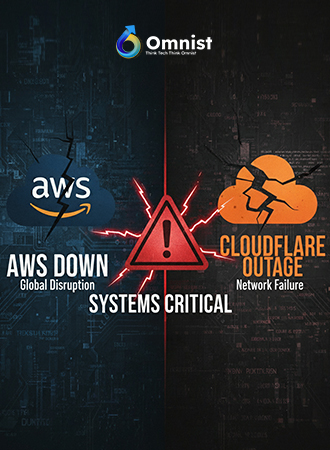Tech News 19 Nov, 2025
Cloudflare Down Yesterday & AWS Outage Last Month: Why the Internet Keeps Breaking — And What Businesses Must Do Next

In the last few weeks, the internet has faced multiple disruptions that once again exposed how dependent the digital world is on a handful of major infrastructure providers. Yesterday, Cloudflare faced a major outage, temporarily impacting millions of websites, SaaS tools, and digital services. Just a few weeks earlier, the world experienced another large-scale breakdown when AWS (Amazon Web Services) went down, causing businesses across the globe to lose access to servers, applications, APIs, and mission-critical operations.
These repeated incidents raise an important question:
Why does the internet keep breaking — and what can businesses do to protect themselves?
What Happened When Cloudflare Went Down Yesterday?
Cloudflare is one of the world’s largest web infrastructure and security companies, powering:
- DNS services
- CDN caching
- DDoS protection
- Firewall & security layers
- Performance optimization
When Cloudflare goes down, it’s not just small websites that fail. Entire platforms slow down or stop working, including:
- E-commerce websites
- SaaS dashboards
- Payment gateways
- Marketing and analytics tools
- Corporate websites
- Streaming platforms
The outage yesterday highlighted how even a short-term issue can instantly disrupt digital operations. Social media was filled with reports of websites showing “Error 500”, “Connection timed out”, and “Service unavailable”.
The reason behind Cloudflare’s outage appears to be a configuration or network routing issue — one of the most common causes for global downtime events. While Cloudflare restored services quickly, the ripple effects lasted for hours.
AWS Went Down Last Month — A Bigger Reminder of Centralization Risks
The AWS outage last month was one of the most disruptive events for business owners and developers around the world. AWS hosts:
- Enterprise applications
- Database servers
- E-commerce backend systems
- CRM and ERP tools
- Banking and fintech infrastructure
- Media and entertainment platforms
- Mobile apps
When AWS goes down, large companies like Netflix, Disney+, Slack, Reddit, and thousands of global businesses feel the impact instantly.
The outage last month was caused by an internal network failure in one of AWS’s largest regions. Even though AWS routes most services redundantly, the incident showed that no cloud provider, no matter how big, is immune to failure.
Why Do These Outages Keep Happening?
While companies like AWS and Cloudflare offer world-class infrastructure, they are still vulnerable to:
- Over-reliance on centralized systems
The internet relies heavily on a few providers — AWS, Google Cloud, Azure, Cloudflare, Akamai, Fastly.
A single failure can disrupt huge portions of the web.
- Increasing complexity in cloud infrastructure
Modern cloud systems involve:
- thousands of interconnected networks
- complex routing rules
- sophisticated security layers
- automated updates
This complexity increases the chance of human error or network conflict.
- Rising cyber threats
DDoS attacks are increasing every year. Even strong security companies like Cloudflare face overwhelming volumes of traffic during attacks.
- Growing dependency on APIs
Today’s websites rely on multiple third-party APIs — payments, shipping, analytics, authentication.
When any of these fail, the entire system breaks.
The Real Problem: Businesses Are Not Prepared
Most companies wrongly assume:
“If I’m on AWS or using Cloudflare, I’m safe.”
But the reality is that no infrastructure provider can guarantee 100% uptime.
The Cloudflare outage yesterday and the AWS outage last month proved that businesses need to plan for failure.
How Can Businesses Protect Themselves From Outages?
- Multi-Cloud & Hybrid Cloud Strategy
Instead of relying on a single cloud provider, businesses should distribute their:
- servers
- databases
- backups
- website hosting
across multiple platforms (AWS + GCP, or Cloudflare + Akamai, etc.)
- Redundant DNS Setup
Use at least two DNS providers:
- Cloudflare
- AWS Route 53
- Google Cloud DNS
DNS redundancy ensures websites stay accessible even when one provider goes down.
- Enable CDN Failover
Many CDNs offer automatic failover routing — enabling it can redirect traffic instantly if the main CDN fails.
- Use Automated Monitoring Tools
Tools like:
- UptimeRobot
- Datadog
- New Relic
- Pingdom
help businesses detect issues instantly and respond faster.
- Maintain Local & Offsite Backups
Downtime is painful, but data loss is even worse.
Businesses should store daily backups across multiple locations.
Final Thoughts: The Internet Is Strong — But Not Unbreakable
Yesterday’s Cloudflare outage and last month’s AWS crash remind us that the digital world is powerful but fragile. Companies must stop assuming outages won’t affect them — and instead, build infrastructure that is ready for unexpected failures.
The future belongs to businesses that prepare today.
 }})
 }})






